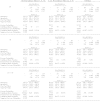Evaluation of Performance of Two Rapid Tests for Detection of HIV-1 and -2 in High- and Low-Prevalence Populations in Nigeria
- PMID: 26311857
- PMCID: PMC4609716
- DOI: 10.1128/JCM.01432-15
Evaluation of Performance of Two Rapid Tests for Detection of HIV-1 and -2 in High- and Low-Prevalence Populations in Nigeria
Abstract
The availability of reliable human immunodeficiency virus types 1 and 2 (HIV-1/2) rapid tests in resource-limited settings represents an important advancement in the accurate diagnosis of HIV infection and presents opportunities for implementation of effective prevention and treatment interventions among vulnerable populations. A study of the potential target populations for future HIV vaccine studies examined the prevalence of HIV infections at six selected sites in Nigeria and evaluated the use of two rapid diagnostic tests (RDTs) for HIV. The populations included market workers at sites adjacent to military installations and workers at highway settlements (truck stops) who may have a heightened risk of HIV exposure. Samples from 3,187 individuals who provided informed consent were tested in parallel using the Determine (DT) and Stat-Pak (SP) RDTs; discordant results were subjected to the Uni-Gold (UG) RDT as a tiebreaker. The results were compared to those of a third-generation enzyme immunoassay screen with confirmation of repeat reactive samples by HIV-1 Western blotting. One participant was HIV-2 infected, yielding positive results on both RDTs. Using the laboratory algorithm as a gold standard, we calculated sensitivities of 98.5% (confidence interval [CI], 97.1 to 99.8%) for DT and 98.1% (CI, 96.7 to 99.6%) for SP and specificities of 98.7% (CI, 98.3 -99.1%) for DT and 99.8% (CI, 99.6 to 100%) for SP. Similar results were obtained when the sites were stratified into those of higher HIV prevalence (9.4% to 22.8%) versus those of lower prevalence (3.2% to 7.3%). A parallel two-test algorithm requiring both DT and SP to be positive resulted in the highest sensitivity (98.1%; CI, 96.7 to 99.6%) and specificity (99.97%; CI, 99.9 to 100%) relative to those for the reference laboratory algorithm.
Copyright © 2015, Manak et al.
Figures



References
-
- UNAIDS. 2014. UNAIDS report shows that 19 million of the 35 million people living with HIV today do not know that they have the virus. http://www.unaids.org/en/resources/presscentre/pressreleaseandstatementa....
-
- Anand A, Shiraishi RW, Bunnell RE, Jacobs K, Solehdin N, Abdul-Quader AS, Marum LH, Muttunga JN, Kamoto K, Aberle-Grasse JM, Diaz T. 2009. Knowledge of HIV status, sexual risk behaviors and contraceptive need among people living with HIV in Kenya and Malawi. AIDS 23:1565–1573. doi:10.1097/QAD.0b013e32832cb10c. - DOI - PubMed
-
- World Health Organization. 2010. Delivering HIV test results and messages for retesting and counseling in adults. http://apps.who.int/iris/bitstream/10665/44278/1/9789241599115_eng.pdf. - PubMed
Publication types
MeSH terms
Substances
LinkOut - more resources
Full Text Sources
Medical

